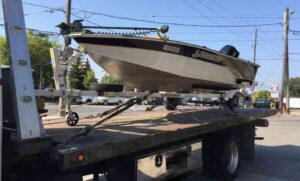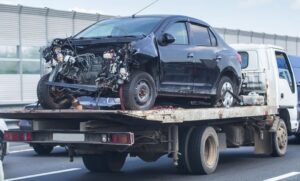The Nissan LEAF holds a special place in the evolution of electric vehicles (EVs), being one of the first mass-market EVs to hit roads globally, including those in Ontario. While its primary motive power comes from a high-voltage lithium-ion battery, like all cars, it relies on a conventional 12-volt (12V) auxiliary battery for critical functions. This 12V battery powers the car’s computers, lights, infotainment system, and, crucially, the relays that “start” the high-voltage system. When this 12V battery dies, your Nissan LEAF won’t “start” or respond, leaving you stranded.
For Nissan LEAF owners in Aurora and across Ontario, knowing how to jump start a Nissan LEAF is an essential piece of knowledge. It’s different from jump-starting a gasoline car, but perfectly achievable with the right approach. At Pars Towing, we frequently assist EV owners with 12V battery issues, and we’re here to guide you through the process safely, or provide professional assistance when needed.
- Learn More >>>>Car Battery Booster
1. Understanding the Nissan LEAF’s Two Batteries (and Why One Matters for Jump Starting)
The fundamental difference between jump-starting an EV like the Nissan LEAF and a gasoline car lies in understanding its dual battery system:
- High-Voltage (HV) Traction Battery: This is the large lithium-ion battery pack, typically located under the floor of the vehicle. It powers the electric motor for propulsion and is what gives the LEAF its range. You do NOT jump start this battery directly, and you should never attempt to.
- 12-Volt (12V) Auxiliary Battery: This is a much smaller, conventional lead-acid (or sometimes lithium-ion in newer EVs) battery, similar to what’s found in gasoline cars. In the Nissan LEAF, it’s typically located under the hood, just like in a traditional car. Its purpose is to power the low-voltage electronics, accessories, and the necessary relays to boot up the entire EV system. When people talk about jump starting a Nissan LEAF, they are referring to this 12V battery.
A dead 12V battery in a Nissan LEAF will result in:
- No response from the power button.
- No lights on the dashboard.
- No power to the infotainment system.
- Inability to shift out of “Park.”
- Essentially, the car appears completely “dead,” even if the main high-voltage battery has a full charge.
The good news is that just like a gasoline car, you can jump start a Nissan LEAF‘s 12V battery.
- Learn More >>>>Making Car Jump Starter PowerBank
2. Safety First: Precautions Before You Jump Start a Nissan LEAF
Jump starting any vehicle, especially an EV, requires strict adherence to safety protocols. Failure to do so can result in serious injury, vehicle damage, or even fire.
- Read Your Owner’s Manual: Always consult your Nissan LEAF’s owner’s manual for the most accurate and up-to-date jump-starting instructions for your specific model year.
- Wear Safety Gear: Always wear safety glasses and gloves when working near a battery. Remove any metal jewelry (rings, watches).
- No Smoking or Flames: The 12V lead-acid battery can produce explosive hydrogen gas. Keep all sparks, flames, and smoking materials away.
- No Contact: Ensure the two vehicles (your LEAF and the booster vehicle/jump pack) do NOT touch each other.
- Check for Damage: Before connecting cables, visually inspect your LEAF’s 12V battery for any signs of damage, cracks, leaks, or swelling. If you see any, do NOT attempt to jump start. Call Pars Towing immediately.
- Frozen Battery: Never attempt to jump start a frozen battery; it could explode.
- Keep Clear of Moving Parts: Be mindful of cooling fans or other moving parts under the hood.
3. What You’ll Need to Jump Start a Nissan LEAF
You’ll need a few essential items to perform the jump start:
- Jumper Cables: A high-quality set of jumper cables with good insulation and robust clamps.
- Booster Vehicle: Another vehicle with a healthy 12V battery (gasoline, diesel, or another EV, but ensure it’s a 12-volt system).
- OR Portable Jump Pack: A lithium jump pack battery is an excellent alternative, offering convenience and portability. Ensure it’s fully charged and rated for your vehicle’s starting current (CCA).
- Gloves and Safety Glasses: For protection.
- Learn More >>>>Quick Jump Start Service
4. Step-by-Step Guide: How to Jump Start a Nissan LEAF
Follow these steps precisely. The sequence of connecting and disconnecting cables is crucial to prevent sparks and damage.
Step 1: Prepare Both Vehicles (If Using a Booster Vehicle)
- Position Vehicles: Park the booster vehicle (Vehicle B) close enough to your Nissan LEAF (Vehicle A) so that the jumper cables can easily reach, but ensure the vehicles do not touch.
- Turn Off Both Vehicles: Place both vehicles in “Park” (P) and engage their parking brakes. Crucially, ensure the power switch in your Nissan LEAF is in the OFF position. For the booster vehicle, turn off its engine and all unnecessary electrical accessories (headlights, radio, AC).
- Locate the 12V Battery in Your LEAF: In most Nissan LEAF models, the 12V auxiliary battery is located under the hood, usually on the driver’s side or passenger’s side, often covered by a plastic shroud that needs to be removed.
- Identify Terminals: Locate the positive (+) terminal (usually covered by a red cap) and the negative (-) terminal.
Step 2: Connect the Jumper Cables (Precise Sequence is Key!)
Follow this specific sequence carefully:
- Red Clamp 1 (Positive + to Dead Battery): Connect one red (positive) jumper cable clamp to the positive (+) terminal of your Nissan LEAF’s 12V battery.
- Red Clamp 2 (Positive + to Booster Battery): Connect the other red (positive) jumper cable clamp to the positive (+) terminal of the booster vehicle’s 12V battery (or the positive terminal on your jump pack).
- Black Clamp 1 (Negative – to Booster Battery): Connect one black (negative) jumper cable clamp to the negative (-) terminal of the booster vehicle’s 12V battery (or the negative terminal on your jump pack).
- Black Clamp 2 (Negative – to LEAF’s Ground Point): Connect the remaining black (negative) jumper cable clamp to a clean, unpainted metal surface on the engine block or frame of your Nissan LEAF. Do NOT connect this directly to the negative (-) terminal of your LEAF’s 12V battery. This helps to prevent sparks near the battery, which could ignite hydrogen gas. A common ground point might be a metal bolt or bracket on the strut tower or engine frame.
Double-check all connections to ensure they are secure and not touching any moving parts or other metal surfaces.
Step 3: Initiate the Jump Start
- Start Booster Vehicle: If using a booster vehicle, start its engine and let it run for a few minutes (e.g., 5 minutes) to allow some charge to transfer to your LEAF’s 12V battery. If using a jump pack, turn it on according to its instructions.
- Attempt to “Start” Your Nissan LEAF: With the power flowing, try to press the power switch in your Nissan LEAF to the “READY” position. (You may hear some clicks or whirs as the system attempts to boot up.)
- If it doesn’t work immediately: Push the power switch back to the OFF position, wait 10 seconds, and try again. For a deeply discharged 12V battery, it might take a few attempts or require the booster vehicle to run for longer (e.g., 10-15 minutes) to adequately charge the LEAF’s 12V battery.
- Confirm READY Mode: Once successful, the “READY” indicator (green car with arrows) should illuminate on your instrument cluster.

- Learn More >>>>Toyota Service Jump Start a Dead Battery in Seconds
Step 4: Disconnect the Jumper Cables (Reverse Sequence is Key!)
Once your Nissan LEAF is in “READY” mode, it’s time to safely disconnect the cables. This reverse order is crucial to prevent sparks.
- Black Clamp 2 (From LEAF’s Ground): Disconnect the black (negative) clamp from the unpainted metal surface on your Nissan LEAF.
- Black Clamp 1 (From Booster Battery): Disconnect the black (negative) clamp from the booster vehicle’s 12V battery (or jump pack).
- Red Clamp 2 (From Booster Battery): Disconnect the red (positive) clamp from the booster vehicle’s 12V battery (or jump pack).
- Red Clamp 1 (From LEAF’s Battery): Disconnect the red (positive) clamp from your Nissan LEAF’s 12V battery.
Do NOT let the clamps touch each other or any metal on either vehicle during disconnection.
Step 5: Allow Your LEAF to Charge its 12V Battery
After successfully jump-starting your Nissan LEAF, keep the vehicle in “READY” mode (or drive it) for at least 20-30 minutes. This allows the LEAF’s DC-DC converter (which charges the 12V battery from the high-voltage battery) to adequately recharge the 12V battery.
- Important Note: Jump starting does NOT charge the high-voltage (traction) battery. If your high-voltage battery is low on charge, you will still need to connect your LEAF to a charging station or EVSE (Electric Vehicle Supply Equipment) before you can drive any significant distance. The 12V battery provides power for the car’s initial boot-up; the HV battery provides the range.
5. When to Call Pars Towing for Your Nissan LEAF
While knowing how to jump start a Nissan LEAF is empowering, there are many situations where calling a professional service like Pars Towing is the safest and most reliable option for drivers in Aurora and across Ontario:
- Unsafe Location: If your LEAF is stranded on a busy highway shoulder, a blind curve, an unlit road at night, or any location where attempting a jump start would put you or your vehicle at risk.
- No Booster Vehicle/Jump Pack: If you don’t have access to another vehicle or a charged jump pack.
- Unsuccessful Jump Start: If, after following the steps carefully, your Nissan LEAF still won’t enter “READY” mode. This could indicate a more serious underlying issue than just a dead 12V battery (e.g., a completely failed 12V battery that won’t hold a charge, a faulty DC-DC converter, or another electrical fault).
- Physical Limitations or Discomfort: If you’re not physically able to handle jumper cables or uncomfortable working under the hood of an EV.
- Visible Battery Damage: If your LEAF’s 12V battery shows signs of swelling, leaking, or damage. Never attempt to jump start a damaged battery.
- Extreme Cold: In harsh Ontario winters, extreme cold can make batteries (both 12V and even some jump packs) less effective, and working outdoors can be dangerous.
- Main High-Voltage Battery is Depleted: If your LEAF is showing a “low traction battery” warning and is completely out of charge, a 12V jump start will only get the car’s electronics on; you won’t be able to drive until the main battery is charged. Pars Towing can tow you to the nearest charging station.
- Any Doubt or Uncertainty: When in doubt, call the experts. It’s always better to be safe than sorry.

- Learn More >>>>Lithium Jump Pack Battery replacement
6. Pars Towing: Your EV Roadside Assistance Experts in Aurora & Ontario
At Pars Towing, we are fully equipped and trained to provide specialized roadside assistance for electric vehicles like the Nissan LEAF. We understand the unique aspects of EV technology and prioritize the safety of both the vehicle and its owner.
- EV-Specific Knowledge: Our technicians are knowledgeable about EV systems, including the proper procedures for jump-starting 12V batteries and handling high-voltage components with care.
- Professional Jump-Starting Equipment: We carry heavy-duty, professional-grade jump packs designed to safely boost all types of vehicle batteries, including those in EVs.
- Safe Towing for EVs: If your Nissan LEAF requires towing (e.g., after a failed jump start, a depleted main battery, or an accident), we utilize flatbed tow trucks, which are the recommended and safest method for transporting EVs to prevent damage to the drivetrain and battery.
- 24/7 Availability: Roadside emergencies can happen at any time. Pars Towing offers round-the-clock service in Aurora and across Ontario.
- Comprehensive Roadside Services: From battery boosts to tire changes, lockouts, fuel delivery (or transport to a charger for EVs), and accident recovery, we’re your complete roadside solution.
Conclusion
Knowing how to jump start a Nissan LEAF by revitalizing its 12V auxiliary battery is a valuable skill for any EV owner in Ontario. By following the precise steps, especially regarding cable connection sequence and grounding, you can safely get your LEAF’s systems back online.








